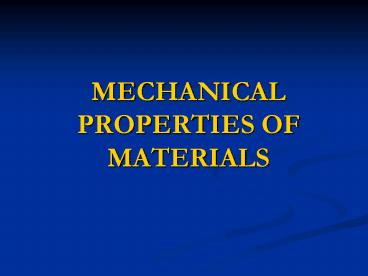MECHANICAL PROPERTIES OF MATERIALS PowerPoint PPT Presentation
1 / 22
Title: MECHANICAL PROPERTIES OF MATERIALS
1
MECHANICAL PROPERTIES OF MATERIALS
2
- Engineers are primarily concerned with the
development and design of machines, structures
etc. - These products are often subjected to forces/
deformations, resulting in stresses/strains, the
properties of materials under the action of
forces and deformations becomes an important
engineering consideration. - The properties of materials when subjected to
stresses and strains are called mechanical
properties. In other words the properties that
determine the behavior of engineering mats under
applied forces are called mechanical
properties.
3
- The response of a material to applied forces
depends on the type and nature of the bond and
the structural arrangement of atoms, molecules or
ions. - Basic deformation types for load carrying
materials are - Elastic deformation (deformations are
instantaneously recoverable) - Plastic deformation (non-recoverable)
- Viscous deformation (time dependent deformation)
4
Elastic Deformation
1. Initial
2. Load
3. Unload
bonds
stretch
return to
initial shape
d
F
Return to the original shape when the applied
load is removed.
Elastic means reversible!
5
Plastic Deformation
1. Initial
2. Load
3. Unload
bonds
p
lanes
stretch
still
planes
sheared
shear
d
plastic
d
elastic plastic
F
F
Could not return to the original shape when the
applied load is removed.
linear
linear
elastic
elastic
d
d
d
elastic
plastic
Plastic means permanent!
6
Viscous Deformation
- Plastic deformations in noncrystalline solids (as
well as liquids) occurs by a viscous flow
mechanism. Usually attributed to fluids. But
solids may also behave like viscous materials
under high temperature and pressure. - Viscous materials deform steadily under stress.
- Deformations are time dependent.
7
- Based on the abovementioned deformation
characteristics, several material idealizations
could be made. Such as - Elastic Materials
- Plastic Materials
- Elastoplastic Materials
- Viscoelastic Materials
8
1. Elastic Materials
- Return to the their original shape when the
applied load is removed.
P
Unloading
Loading
d
9
2. Plastic Materials
- No deformation is observed up to a certain
limit. Once the load passes this limit,
permanent deformartions are observed.
P
Limit
Unloading
Loading
d
Plastic deformation
10
3. Elastoplastic Materials
- Up to a limit shows elastic properties. Within
this limit if the load is removed, returns to its
original shape. If the load passes the limit,
plastic deformations are observed.
P
Elastic Limit
d
Plastic deformation
Elastic deformation
11
4. Viscoelastic Material
- Deformations are time-dependent.
P
Fast Loading-Unloading
Slow Loading-Unloading
d
12
ISOTROPIC and ANISTROPIC Materials
13
- The physical properties of some substances depend
on the crystallographic direction in which the
measurements are taken. - For example, the elastic modulus, the electrical
conductivity, and index of refraction may have
different values in the 100 and 111
directions. - This directionality of properties is termed as
anisotropy, and it is associated with the
variance of atomic or ionic spacing with
crystallographic direction. - Substances in which the measured properties are
independent of the direction of measurement are
called isotropic.
14
(No Transcript)
15
- Isotropic materials have the same mechanical
properties in all directions. - Anisotropic materials show different behavior in
different directions.
Isotropic Materials (METALS)
d1 d2
d1
?
d2
Anisotropic Materials (WOOD)
d1? d2
?
16
Hooke's Law
Hooke's Law For elastic materials, stress is
linearly proportional to strain and is
independent of time.
Modulus of Elasticity, E
F
s
s E e
E
e
F
Linear-
simple
tension
elastic
test
17
- For an anisotropic material, the linear equations
between stress and strain components will be
given by the following six equations known as the
Generalized Form of Hookes law. - sxx C11exxC12eyyC13ezzC14?xyC15?xzC16?yz
- syy C21exx C22eyyC33ezz...........
- szz C31exx C32eyy..........
- txy C41exx ...........
- txz C51exx ...........
- tyz C61exx ...........
18
- The six equations of Generalized Hookes Law can
be written in matrix form
Elastic constants
Strains
Stresses
19
- Stress-strain relationships such as these are
known as constitutive relations. - It can be shown that C12C21, C31C13...
- Therefore, the number of elastic constants
reduce to 21 for an anisotropic material. - The number of independent elastic constants
reduce to 2 for isotropic materials. In fact,
there are 4 constants (E, ?, K, G) 2 of which are
independent.
Elastic constants
20
- For an isotropic material the Generalized Hookes
Law yields
E, n and G are known as elastic constants.
21
ISOTROPIC MATERIAL in UNIAXIAL TENSION
22
ISOTROPIC MATERIAL in PURE SHEAR

